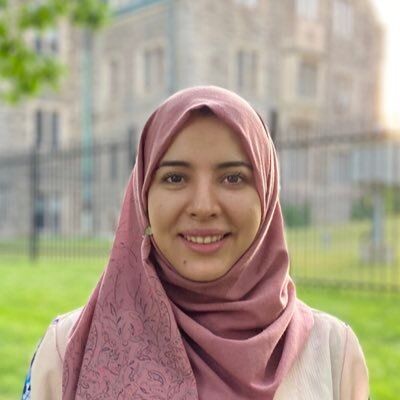Somayeh Norouzi-Ghazbi, Occupational Science and Occupational Therapy

Supervisor: Dr. Sander Hitzig (Department of Occupational Science and Occupational Therapy, Temerty Faculty of Medicine, University of Toronto [UofT], & St. John’s Rehabilitation - Sunnybrook Health Sciences Centre)
Co-supervisors:
Dr. Jan Andrysek (Institute of Biomedical Engineering (BME), Faculty of Applied Science and Engineering, UofT, & Holland Bloorview Kids Rehabilitation Hospital)
Dr. Roger Goldstein (Rehabilitation Science Institute, Temerty Faculty of Medicine, UofT, & West Park Healthcare Centre)
PhD Title: Modeling and Visual Servoing of Single and Cooperative Continuum Robots
PhD Description:
continuum robots (CRs)' applications have been on the rise due to their continuum backbone structure and compliance, enabling them to operate in constrained spaces, and making them a safer choice for minimally invasive surgeries. Dr. Norouzi's PhD thesis "Modeling and Visual Servoing of Single and Cooperative Continuum Robots" dealt with modeling and visual servoing (VS) of CRs and one of their recently introduced configurations, cooperative-CRs (CCRs). CCRs consist of a set of CRs cooperating on a defined operative task. To provide a basis for development of the controller, Dr. Norouzi modeled dynamics of tendon-driven small-sized CRs with continuous interaction between their tendons and backbones, for the first time, and also developed an efficient kinematic modeling for a CCR configuration.
Next, she developed two controllers, one to control a single CR in large displacements and another one to control a cooperative set of CRs. A cooperation task between two CRs can be broken down into two different phases. In the first phase (associated with large movements) a single-CR (the operative-CR) needs to be navigated to the point of interest. In this phase, Dr. Norouzi developed a visual predictive control system and successfully controlled a single-CR in the presence and absence of various actuation and environmental constraints. If navigation to the target point could not be achieved because of the point being located outside the workspace of the operative-CR, a CCR configuration would be formed by attachment of a supportive-CR to the operative-CR (second phase of movement). Thus, a push from the SCR will help OCR reaches the target point. Dr. Norouzi introduced a new Lyapunov-based switching visual servoing control approach to control Cosserat-based CCRs for the first time.
Scholarships & awards
Postdoc
• Student Ideator Fellowship Award, 2022 Praxis Ideation Challenge, Praxis Spinal Cord Institute (2022).
• E-accelerate Mitacs, Mitacs Canada & University of Toronto, (2022).
• Mitacs-Lab2Market, Atlantic Canada Opportunities Agency & Mitacs Canada, (2022).
PhD
• Teaching Development TA/GA Award, Centre for Excellence in Learning and Teaching, Ryerson University, (2021).
• Norman Esch Engineering Innovation and Entrepreneurship Award-stage 1, Ryerson University, (2021).
• Joseph Zboralski TA/GA Equity and Inclusion Award, Ryerson University, (2021).
• Graduate Research Stipend, Ryerson University (2016-2020).
• The Faculty of Engineering and Architectural Science Graduate Funding, Ryerson University (2016-2020).
• Ryerson University International Student Scholarship, Ryerson University (2019-2020).
• Ryerson Graduate Development Award, Ryerson University (2016-2020).
• Ryerson Graduate Student Travel Funding, Ryerson University (2020).
MSc
• Singapore International Graduate Award, A*STAR, an award to peruse PhD studies at National University of Singapore (NUS), (2016).
• Graduate Research Development Award (Hashemi Nejad Award), one of 23 recipients out of 300 applicants, Ferdowsi University of Mashhad, Iran (2013).
BSc
• The National Honor Undergraduate Student Recognition, appreciated by the president of Iran and the Minister of Science, Research and Technology, every year only 14 undergraduate students over the entire country can achieve this title, (2011).
• First and third ranks, Conceptual and Industrial Design of Hybrid Electric Vehicles, National CAR Design Competition of Sharif University, Tehran, Iran, (2011).
• Best paper, Design, and manufacturing of a Solar Glider (PARTO), the 6th Iranian Student Conference, Industrial University of Amir Kabir, (2010).
Sample journal publications
• Norouzi-Gh, S., Janabi-Sharifi, F., “A switching image-based visual servoing of cooperative continuum robots”, Journal of Intelligent and Robotic System, IF: 2.02, (2021).
• Norouzi-Gh, S., Mehrkish, A., Fallah, M., Janabi-Sharifi, F., “Constrained visual predictive control of tendon-driven continuum robots”, Robotics and Autonomous Systems, IF: 3.12, Vol (145), (2021).
• Norouzi-Gh, S., Mehrkish, A., Abdulhafiz, A., Abbasihashemi, T., Mahdi, A., Janabi-Sharifi, F., “Design and experimental evaluation of an automated catheter operating system”, Artificial Organs, Vol (45), No (6), IF: 3.1, (2021).
• Jabbari, M., Zakeri, M., Janabi-Sharifi, F., Norouzi-Gh, S., “Inverse kinematics of concentric tube robots in the presence of environmental constraints”, Applied Bionics and Biomechanics Journal, IF: 1.7, Vol. (2021), (2021).
• Norouzi-Gh, S., Janabi-Sharifi, F., “Dynamic modeling and system identification of internally-actuated small-size continuum robots”, Mechanism and Machine Theory, Vol (154), IF: 3.9, (2020).
• Norouzi-Gh, S., Akbarzadeh, A., Akbarzadeh, M., “Application of Taguchi design in system identification: A simple, generally applicable and powerful method”, Measurement, Vol (151), IF: 3.9, p. 106879, (2019).
• Norouzi-Gh, S., Akbarzadeh T., A., S., Kardan, I., “Statistically optimized FOPID for output force control of SEAs”, Advanced Robotics, Taylor and Francis, IF: 1.05, (2018).
• Norouzi-Gh, S., Alimohammadi, M., Aghli, Y., Akbari, A.A., “Quadrotors unmanned aerial vehicles: A review”, The International Journal on Smart Sensing and Intelligent Systems, Vol (9), No. (1), ISSN: 1178-5608, IF: 1.24, (2016).
Current research
Dr. Norouzi is now working on a solution to the poor physical recovery, especially in remote rehabilitation. Her Mitacs research project is on development of a tele-health rehabilitation system with the purpose of providing automatic assessment of patients’ performance and improving patients’ adherence.